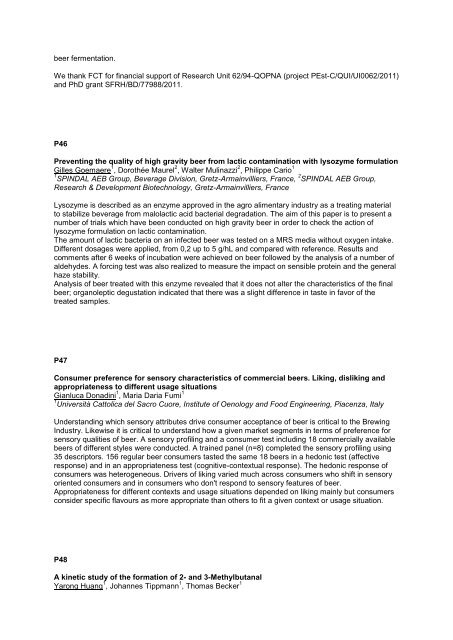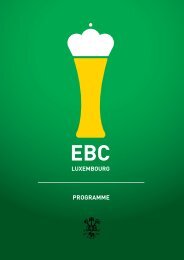here - the 34th European Brewery Convention
here - the 34th European Brewery Convention
here - the 34th European Brewery Convention
You also want an ePaper? Increase the reach of your titles
YUMPU automatically turns print PDFs into web optimized ePapers that Google loves.
eer fermentation.<br />
We thank FCT for financial support of Research Unit 62/94-QOPNA (project PEst-C/QUI/UI0062/2011)<br />
and PhD grant SFRH/BD/77988/2011.<br />
P46<br />
Preventing <strong>the</strong> quality of high gravity beer from lactic contamination with lysozyme formulation<br />
Gilles Goemaere 1 , Dorothée Maurel 2 , Walter Mulinazzi 2 , Philippe Cario 1<br />
1 SPINDAL AEB Group, Beverage Division, Gretz-Armainvilliers, France, 2 SPINDAL AEB Group,<br />
Research & Development Biotechnology, Gretz-Armainvilliers, France<br />
Lysozyme is described as an enzyme approved in <strong>the</strong> agro alimentary industry as a treating material<br />
to stabilize beverage from malolactic acid bacterial degradation. The aim of this paper is to present a<br />
number of trials which have been conducted on high gravity beer in order to check <strong>the</strong> action of<br />
lysozyme formulation on lactic contamination.<br />
The amount of lactic bacteria on an infected beer was tested on a MRS media without oxygen intake.<br />
Different dosages were applied, from 0,2 up to 5 g/hL and compared with reference. Results and<br />
comments after 6 weeks of incubation were achieved on beer followed by <strong>the</strong> analysis of a number of<br />
aldehydes. A forcing test was also realized to measure <strong>the</strong> impact on sensible protein and <strong>the</strong> general<br />
haze stability.<br />
Analysis of beer treated with this enzyme revealed that it does not alter <strong>the</strong> characteristics of <strong>the</strong> final<br />
beer; organoleptic degustation indicated that t<strong>here</strong> was a slight difference in taste in favor of <strong>the</strong><br />
treated samples.<br />
P47<br />
Consumer preference for sensory characteristics of commercial beers. Liking, disliking and<br />
appropriateness to different usage situations<br />
Gianluca Donadini 1 , Maria Daria Fumi 1<br />
1 Università Cattolica del Sacro Cuore, Institute of Oenology and Food Engineering, Piacenza, Italy<br />
Understanding which sensory attributes drive consumer acceptance of beer is critical to <strong>the</strong> Brewing<br />
Industry. Likewise it is critical to understand how a given market segments in terms of preference for<br />
sensory qualities of beer. A sensory profiling and a consumer test including 18 commercially available<br />
beers of different styles were conducted. A trained panel (n=8) completed <strong>the</strong> sensory profiling using<br />
35 descriptors. 156 regular beer consumers tasted <strong>the</strong> same 18 beers in a hedonic test (affective<br />
response) and in an appropriateness test (cognitive-contextual response). The hedonic response of<br />
consumers was heterogeneous. Drivers of liking varied much across consumers who shift in sensory<br />
oriented consumers and in consumers who don't respond to sensory features of beer.<br />
Appropriateness for different contexts and usage situations depended on liking mainly but consumers<br />
consider specific flavours as more appropriate than o<strong>the</strong>rs to fit a given context or usage situation.<br />
P48<br />
A kinetic study of <strong>the</strong> formation of 2- and 3-Methylbutanal<br />
Yarong Huang 1 , Johannes Tippmann 1 , Thomas Becker 1





